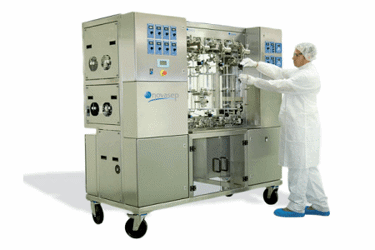Single-Use Chromatography: The Solution To Downstream Processing Bottlenecks?

By A. Mark Trotter, Trotter Biotech Solutions
Over the last 35 years, the biopharmaceutical industry has accepted, as part of an ongoing process, a wide range of single-use system (SUS) technologies. Initial adoption of filter capsules and plastic tubing has grown in complexity and scale from the early 1980s through today. Now, manufacturers are able to replace most hardware components, including stainless steel vessels/piping/sanitary flanges, and glass vessels, with single-use polymeric devices and components. Thanks to a large and diverse offering of single-use products, what was once primarily an upstream technology has begun expanding into downstream processes.
One notable exception to this trend has been chromatography columns and their multifarious support equipment and instrumentation — long recognized as an important bottleneck in scaling up, expanding, and increasing rapid purifications processes.
Used for product purification through bind-elute/pass-through processes, column chromatography has proved challenging to transfer into disposable formats. The primary issue has been the cost of the affinity/ion exchange (IEX) resins, which end-users had to amortize through clean-and-reuse programs.
However, recent advances have now made recycling and disposable chromatography systems possible at reasonable costs. Through the use of various ion exchange technologies, membrane/ligand formats, polymeric column construction, and innovative scaling technologies, chromatographic separations and purification operations are now moving into the realm of downstream applications through disposable product concepts like pre-packed columns, recycling columns post-campaign, continuous processing, and simulated moving bed chromatography.
From Molecular Diffusion To Membrane Adsorption
Traditional column chromatography relies on molecular diffusion to transport the target species through the microporous structure of resin beads to internal binding sites.
Column chromatography for flow-through or bind-elute ionic exchanger polishing steps operates at flow rates measured in centimeters/hour. This relatively slow passage demands rather large-diameter columns, upward of 1.0 meter, to achieve reasonable flow rates. At these diameters, fill volumes can require resin beads in the hundreds of liters, at substantial cost. In order to reach acceptable flow rates, much of the columns’ adsorptive capacity may not be maximized. There are also difficulties when purifying large molecular weight molecules, such as host cell proteins (HCP), DNA, viruses, endotoxins, and large proteins. These species present diffusion challenges due to their size and inability to move freely into the micropores of resin beads.
These drawbacks of ionic exchange columns fueled the development and adoption of membrane adsorber chromatography, at first for contaminant reduction/removal (e.g., HCP, DNA, etc.) and subsequently for use in protein purification applications. The contaminants are directly bound to the membrane’s charged ligands, eliminating the need for diffusive migration into resin beads.
The higher flow rates of membrane adsorbers is due to the open pore structure of the membrane — typically 5 to 8 µm, which offers no restriction to very high molecular weight species — coupled with high binding capacities. These higher flow rates, measured in milliliters/minute, significantly decrease processing times and greatly improve throughput. The membrane structure also considerably decreases hold-up volumes in single-use disposable chromatography devices. The need for high-volume buffer rinses to flush high-value product is thus reduced, resulting in further processing cost reduction.
When comparing traditional stainless steel / glass columns to membrane chromatography, the cost models should consider all aspects of operation, including capital equipment, materials, consumables, cleaning, and labor. Overall operating costs for disposable membrane chromatography are reduced despite an increase in consumable costs. The comparable antibody yield for membrane adsorber chromatography is on order with traditional cation exchange (CEX) column chromatography.
Advantages Of Single-Use Chromatography Columns
Today, there are many disposable chromatography column systems available that meet regulatory cGMP requirements and industry standards. Besides sanitary design, material of construction qualification, and installation/operational/performance qualification (IQ/OQ/PQ), end-users are also demanding SUS products that enable them to reduce costs in both processes and systems, and achieve higher yields and product purity. Following are some of the features of SUS chromatography that are helping biopharmaceutical manufacturers achieve these goals.
- Reproducibility: This is a key consideration during column setup and packing. Reproducible performance as measured by using peak symmetry and elution profiles, must be achieved each time the column is packed and/or recycled, and assumes resin and chromatography bind and elute procedures are identical. Each pre-packed disposable column must be reproducible from batch to batch.
- Scalability: Optimization of the chromatography process, from benchtop small-volume column diameters to large process columns, must be scalable up and down. The packing and condition steps should generate the same performance regardless of the column diameter. This is a major failing of many reusable systems.
- Speed: The recent gains in upstream protein titers — upward of 10 to 15 grams per liter (g/L) — places greater focus on the downstream separation and chromatography purification processes. Addressing this growing chromatography bottleneck problem, process development teams persistently seek production improvements to speed-up the rate-limiting chromatography step. Decreasing time spent repeatedly packing and unpacking columns can increase turn-around cycle times, thereby reducing downtime and increasing production efficiencies. Using pre-packed disposable column systems, column maintenance time is eliminated.
- Ease-of-use: Single-use chromatography systems, and pre-packed recyclable or single-use columns campaigns, require quick connections and standard fittings. The plug and play concept applied to other single-use downstream polymeric devices should apply to these column products as well.
- Operational safety: The benefit associated with upstream single-use disposable devices also carries over to chromatography products. For example, the use of sanitizing and cleaning chemicals can be minimized. As these columns are self-contained units, the risk of accidental chemical exposure to the operator during setup, take down, and disposal can be greatly reduced or eliminated.
Future Developments In Single-Use Chromatography
The single-use/disposable chromatography column and membrane products continue to develop, as manufacturers bring new innovative products to downstream processes. Although membrane chromatography is not a new technology, the recent expansion of salt-tolerant robust adsorber devices and newer ionic ligand technologies are beginning to fulfill end-user demand. Similarly, single-use column chromatography product offerings continue to flow into the downstream processes, from simulated moving bed chromatography systems that operate continuously to pre-packed and dedicated ”campaign” columns.
On the horizon, monoclonal antibody (mAb) purification by disposable protein A column replacement may very well be the next downstream processing bottleneck to be tackled. Chromatography resin and drug manufacturers have developed and evaluated alternate technologies for antibody purification as alternatives to the protein A capture step.
These capture steps include the use of mixed-mode chromatography (MMC), such as hydrophobic charge induction chromatography (HCIC) and synthetic protein A mimetic resins. Adsorption of antibodies to HCIC resins results from a combination of these MMC interactions (hydrophobic and ionic exchange) and eluting the antibody using low (<3.0) pH buffer. While this technology has been shown to be effective, MMC performance can result in lower yields and have higher impurity profiles due to increased non-specific binding.
Synthetic ligand media is another potential alternative to protein A. Resin manufacturers have developed synthetic protein A ligands based on hydrophobic IgG binding sites of protein A, using procedures like protein engineering and synthetic chemistry. Studies demonstrated that the binding of antibodies using protein A synthetic resins could produce comparable product throughput and quality. Shortcoming of synthetic protein A ligands include reduced selectivity, lower affinity, and non-specific adsorption, as compared with biological ligands.
Although the capital expenditure for MMC and synthetic protein A ligands may be higher than for typical SUS devices/equipment, these innovative capture technologies require a capital investment typical of any chromatography process. The costs will be amortized and represent approximately 3% of total manufacturing costs. Plus, these technologies can be considered disposable resins for use in campaigns or pre-packed columns. In such cases, the cost would be similar to standard affinity or IEX resins, which are a faction (10 to 15 percent) of the cost of protein A media, making these technologies feasible for use in biopharmaceutical manufacturing.
Image credit: Sequential Multicolumn Chromatography (SMCC) for Biomolecules, courtesy of Novasep
About The Author:
 With over 20 years’ experience in the life sciences, A. Mark Trotter provides technical consultancy services and training programs to the pharmaceutical, biologics, and bioprocessing industries. He has specialized training and experience in membrane technologies, including sterilizing filtration liquid/gases, prefiltration, chromatography, virus clearance, and single-use technologies. His areas of subject matter expertise span from upstream cell culture / fermentation to downstream applications, including separation, clarification, and purifications processes.
With over 20 years’ experience in the life sciences, A. Mark Trotter provides technical consultancy services and training programs to the pharmaceutical, biologics, and bioprocessing industries. He has specialized training and experience in membrane technologies, including sterilizing filtration liquid/gases, prefiltration, chromatography, virus clearance, and single-use technologies. His areas of subject matter expertise span from upstream cell culture / fermentation to downstream applications, including separation, clarification, and purifications processes.
Mr. Trotter has published numerous technical articles and book chapters. He is a member of PDA (Parenteral Drug Association), ASM (American Society of Microbiology) International Society for Pharmaceutical Engineering, (ISPE), and the American Society of Quality (ASQ), while serving on the ASTM E55 Biopharma Group and the USP Filtration Expert Panel. He actively participates on various technical committees and regularly presents papers at society meetings and for interest groups.
Mr. Trotter earned his MS in medical microbiology and MBA in finance, both from Long Island University – C.W. Post. You can reach him at mark@Trotterbiotech.com or connect with him on LinkedIn.
